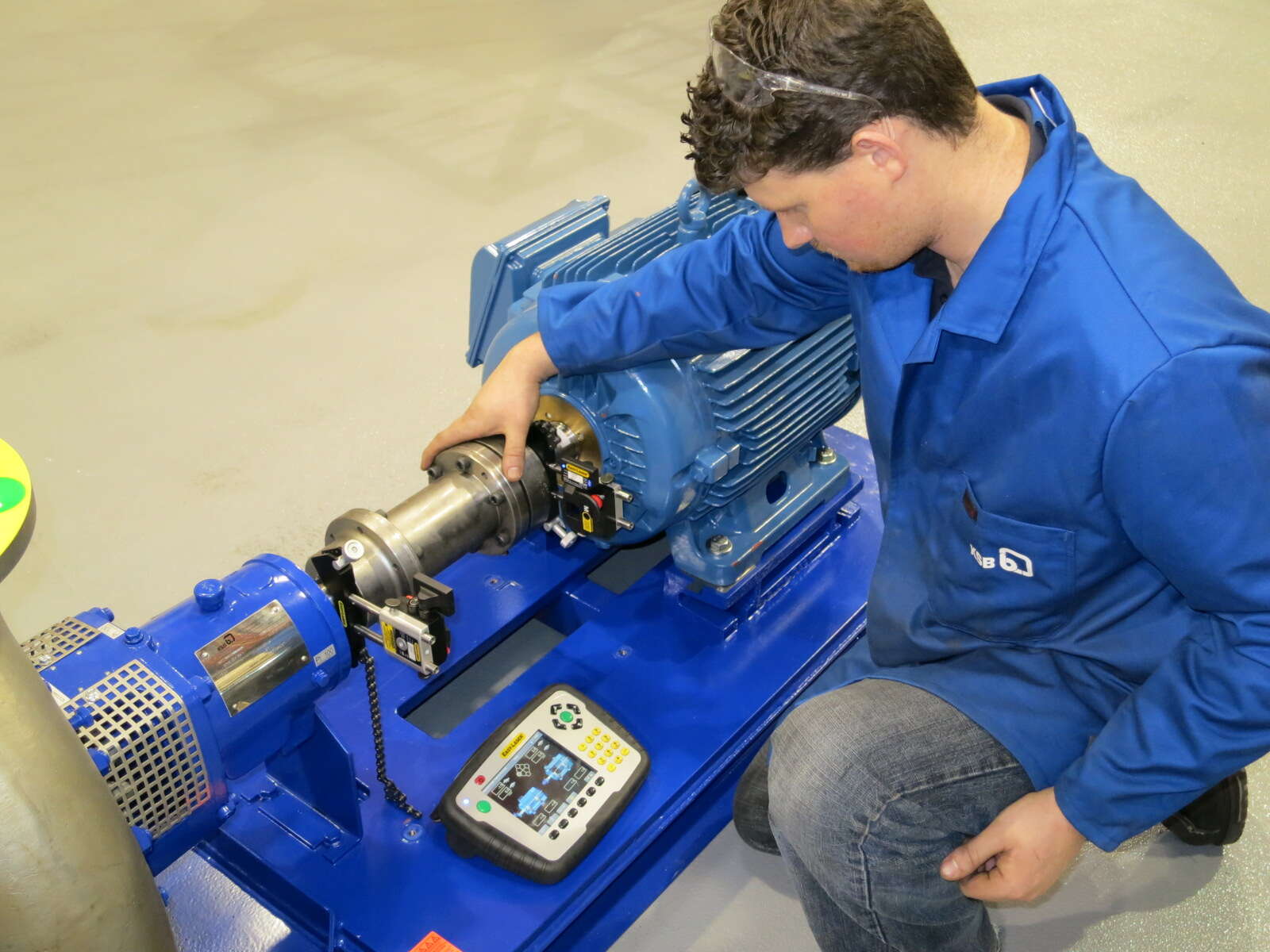
Alignment of Pumps
One of the most important parts of pump setup is making sure that the pump and the drive motor are carefully aligned. Misalignment may account for over 50% of malfunctions in rotating machinery, leading to problems such as worn or broken couplers, vibration, and excessive wear of bearings, seals and wear rings. Excessive misalignment can even cause breakage of mounts or pump/motor casings.
KSB (and most other manufacturers) deliver pump sets (pump plus motor) mounted on a baseplate and pre-aligned at the factory. However, small movements of these components can occur during shipping and while the pump set is being installed at its final location. It is highly recommended to check and, if necessary, correct pump-motor alignment as part of the commissioning process, before the pump is placed in service. The customer is responsible for ensuring that the baseplate is mounted securely on a properly constructed foundation. In particular, the top surface of the foundation must be carefully prepared so that the baseplate can be anchored without being overstressed or distorted.
Once the pump set has been properly installed, the final alignment can be checked and, if necessary, corrected. Obviously re-alignment is needed whenever the pump or motor are moved or replaced.
What do we mean by ‘alignment’?
Long-coupled pumps have separate pump and motor shafts that are connected through a coupler. Ideally these two shafts will be exactly parallel and have exactly the same centre-line. Flexible couplers can tolerate small alignment errors, but for smooth, trouble-free running, it is important to ensure that these two shafts are lined up to within the tolerances specified by the pump, motor and coupler manufacturers.
There are two types of misalignment that can lead to running problems. Angular misalignment occurs when the centrelines of the motor shaft and the pump shaft are at an angle to each other.
Angular misalignment
Parallel misalignment occurs when the shafts are parallel, but the centrelines are displaced vertically or horizontally with respect to each other.
Parallel misalignment
Improperly aligned machines will typically suffer from a combination of angular and parallel misalignment.
Measuring Misalignment
The first step in getting motors and pumps lined up properly is to measure the degree of misalignment. The procedures for doing this are conceptually simple, but can be tricky to do accurately in the field.
For angular misalignments, a simple approach is as follows:
- With the motor and pump shaft flanges close to each other, but disconnected, mark a spot on each shaft, then measure the separation between them with a feeler or taper gauge.
- Rotate both shafts by about 90 degrees, keeping the marks close to each other. Measure the separation distance again. Repeat for 180 and 270 degrees.
- If the measured separation stays the same as the shafts are rotated, they can be assumed to be parallel. However, differences in measured flange separation indicate that the shafts are not perfectly lined up
A similar procedure can be used to measure parallel misalignment. Here, a straightedge would be laid across one of the flanges and the distance to the other flange measured.
Parallel misalignment
Again, both shafts should be rotated the same amount and the changes in measured distances noted.
Dial gauges or laser measurement devices are often used to provide more accurate measurements of the degree of misalignment between the motor and pump shafts. Laser devices provide higher levels of accuracy and also have automated features that simplify and speed up the work of measuring alignment.
Checking alignment with laser measurement equipment
Correcting Misalignment
Correcting misalignments requires re-positioning the pump or the motor so that the centerlines of their shafts line up properly. Since pumps are usually attached to piping systems, it’s usually easier to move the motor. Small adjustments to the motor position in the horizontal plane are usually accomplished by loosening the motor anchor bolts, shifting the motor sideways, then re-tightening the bolts. Vertical adjustments are usually made by adjusting leveling screws or by adding or removing shims under the motor’s feet. Care should be taken with the selection of shims. A few relatively thick shims are preferable to a stack of thin shims, since the thicker shims generally result in stiffer, more secure supports for the motor.
Naturally, whenever either the pump or the motor have been re-positioned, it is necessary to re-check the alignment.
Foot Problems
Warped, damaged or poorly mounted baseplates, poorly selected shims or loose anchor bolts can all contribute to a condition known as soft or spongy feet. When this occurs, it will be very difficult – even impossible – to get the rotating machines properly aligned. Even if everything looks good while the machinery is shut down, operating loads, including motor torque and thermal stresses can throw things off when the pump begins to run. For this reason, it is important to check the condition of the baseplate, the anchor bolts and the pump and motor casings before attempting to align the rotating machinery. Modern laser measurement devices can help detect foot problems my measuring small changes in position of the pump and motor when they begin to run.